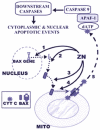Zinc and zinc transporters in normal prostate and the pathogenesis of prostate cancer
- PMID: 15970489
- PMCID: PMC4461430
- DOI: 10.2741/1692
Zinc and zinc transporters in normal prostate and the pathogenesis of prostate cancer
Abstract
Zinc is an essential metal for all cells. It plays a role in a wide variety of physiological and biochemical processes. In the prostate epithelial cell the accumulation of high cellular zinc is a specialized function that is necessary for these cells to carry out the major physiological functions of production and secretion of citrate. The production of citrate and its secretion into prostatic fluid is a differentiated function of the prostate epithelial cells that is apparently important for reproduction. The loss of citrate and zinc accumulation is the most consistent and persistent characteristic of prostate malignancy. This characteristic of prostate cancer indicates that the lost ability of the malignant cells to accumulate zinc and citrate is an important factor in the development and progression of malignancy. The lost ability of the epithelial cells to accumulate zinc and thus to also accumulate citrate is the result of decreased expression of specific zinc uptake transporters. The purpose of this presentation is to review the current understanding of zinc and zinc homeostasis in the prostate and the role of zinc and zinc transporters in the normal function of the prostate and the pathogenesis of prostate cancer.
Figures







References
-
- Krebs NE, Hambidge KM. Zinc metabolism and homeostasis: the application of tracer techniques to human zinc physiology. Biometals. 2001;14:397–412. - PubMed
-
- Liuzzi JP, Cousins RJ. Mammalian zinc transporters. Annu Rev Nutr. 2004;24:151–172. - PubMed
-
- Maret W. Zinc and sulfur:a critical biological partnership. Biochemistry. 2004;43:3301–3309. - PubMed
-
- Vallee BL, Falchuk KH. The biochemical basis of zinc physiology. Physiol Rev. 1993;73:79–117. - PubMed
-
- Vallee BL. Biochemistry, physiology and pathology of zinc. Physiol Rev. 1992;39:443–490. - PubMed
Publication types
MeSH terms
Substances
Grants and funding
LinkOut - more resources
Full Text Sources
Other Literature Sources
Medical
